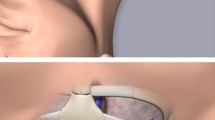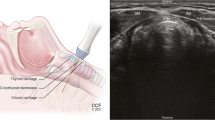Abstract
Background
The placement of an internal jugular vein (IJV) catheter is considered to be more difficult in morbidly obese patients. The objective of this study was to compare the success of simulated IJV puncture between morbidly obese patients and a nonobese control group.
Methods
Thirty-four morbidly obese patients with body mass index (BMI, kg/m2) ≥40 were compared with 36 patients with BMI < 30. Right IJV puncture was simulated using an ultrasound probe directed towards the sternal notch at the midpoint between the sternal notch and the mastoid process. The investigator placing the probe was blinded as to the image being created on the ultrasound machine. Success rate was assessed at three different head rotation angles from midline; 0°, 30°, and 60°.
Results
There was no statistically significant difference in successful simulated IJV puncture between two groups for any of the head positions. However, there was a higher incidence of the carotid artery (CA) puncture in the morbidly obese patient group when the head rotation was advanced from neutral position to 60° (p < 0.05). In addition, the ultrasound showed significantly more overlapping of the IJV over the CA in morbidly obese patients at 0° (p < 0.05) and 30° (p < 0.05). Our results show no statistically significant difference in success rate of IJV puncture between morbidly obese patients and nonobese patients. Keeping the head in a neutral position in morbidly obese patients minimizes the overlapping of the IJV over the CA and the risk of CA puncture.
Conclusion
However, due to the fact that even in the neutral position there is a significant increase in overlap between IJV and CA, we recommend the use of ultrasound guidance for IJV cannulation in obese patients.



Similar content being viewed by others
References
McGee DC, Gould MK. Preventing complications of central venous catheterization. N Engl J Med. 2003;348:1123–33.
Lieberman JA, Williams KA, Rosenberg AL. Optimal head rotation for internal jugular vein cannulation when relying on external landmarks. Anesth Analg. 2004;99:982–8.
Bailey PL, Whitaker EE, Palmer LS, Glance LG. The accuracy of the central landmark used for central venous catheterization of the internal jugular vein. Anesth Analg. 2006;102:1327–32.
Troianos CA, Kuwik RJ, Pasqual JR, et al. Internal jugular vein and carotid artery anatomic relation as determined by ultrasonography. Anesthesiology. 1996;85:43–8.
Sulek CA, Gravenstein N, Blackshear RH, et al. Head rotation during internal jugular vein cannulation and the risk of carotid artery puncture. Anesth Analg. 1996;82:125–8.
Author information
Authors and Affiliations
Corresponding author
Rights and permissions
About this article
Cite this article
Fujiki, M., Guta, C.G., Lemmens, H.J.M. et al. Is it More Difficult to Cannulate the Right Internal Jugular Vein in Morbidly Obese Patients than in Nonobese Patients?. OBES SURG 18, 1157–1159 (2008). https://doi.org/10.1007/s11695-008-9590-z
Received:
Accepted:
Published:
Issue Date:
DOI: https://doi.org/10.1007/s11695-008-9590-z




